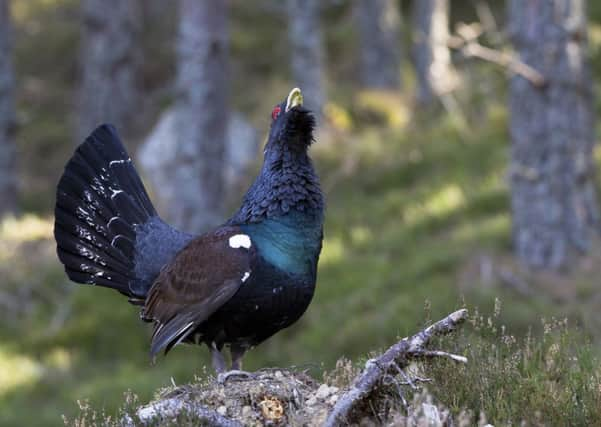Dispute breaks out over capercaillie survival plan


Cairngorm National Park Authority is taking their multi-agency Capercaillie Framework project to the next stage by urging land managers and communities to help protect and expand the numbers of the bird.
But Scottish gamekeepers have hit back by criticising conservationists of “failing to grasp the nettle” and deal with the predator impact of the pine marten.
Advertisement
Hide AdAdvertisement
Hide AdThe park authority meets on Friday to discuss the ongoing work of the framework and their plans to involve the public in their future efforts.
Justin Prigmore, Capercaillie Framework project manager, said: “Public awareness will be a vital part of conservation efforts as human disturbance is a known factor influencing the capercaillie population.
“We will need the help of communities that are near to capercaillie habitat to support the conservation work, which might involve using different routes for dog walking or cycling during the nesting season.
“Local people have a huge part to play in saving this charismatic emblem of our Caledonian forest.”
The population of the capercaillie has been in severe decline since 1970, when there were an estimated 20,000 birds.
Conservationists say there are now around 1,200, although gamekeepers believe it could be as low as 400.
The Cairngorms is the remaining stronghold for capercaillie, with at least 80 per cent of the national population.
Responding to the framework proposals, a Spokesman for the Scottish Gamekeepers Association said: “It must be questioned how much of a priority capercaillie survival is, beyond sound-bites, if plans to conserve it make no mention of predator impact.
Advertisement
Hide AdAdvertisement
Hide Ad“The inability of conservationists to grasp the nettle on this is like a group of people trying to rescue their dinner while the house is on fire.
“Millions have been spent in removing deer fences and improving forest habitat, yet the decline of capercaillie continues.”
He claimed that workers on the ground believe that the numbers may be as low as 400, adding: “On 20 video monitored nests in Abernethy Forest, 65 per cent of nests were found to be predated, 57 per cent of those by pine marten.
“Given this science within the core area, and the rise in number of pine marten, it is surely common sense to proceed with a trial to translocate pine marten from a small core area to monitor the affects of, and better understand, such predation.”
“If it is found pine marten have no affect on capercaillie, then efforts can be targeted elsewhere or in tandem with what is going on, anyway.”
The Game & Wildlife Conservation Trust (GWCT), a charity funded by landowners, farmers and sporting interests, has indicated it wants to launch a trial next year to trap and relocate pine martens.
But the plan has been condemned as “deeply flawed” by experts who fear it could open the door to the widespread killing of the protected pine martens.
CONNECT WITH THE SCOTSMAN
• Subscribe to our daily newsletter (requires registration) and get the latest news, sport and business headlines delivered to your inbox every morning
Advertisement
Hide AdAdvertisement
Hide AdIt has also been rejected by the Royal Society for the Protection of Birds (RSPB), which owns two of the woodlands where the trial had been proposed.
The gamekeepers spokesman said: “Attempts by groups opposing such a trial to blacken a legitimate conservation attempt should not be allowed to detract from the fact that avoiding a second extinction requires more than is presently being done.”
However, Hamish Trench, director of conservation and visitor experience at the Cairngorm National Park Authority (CNPA), said that the long term habitat expansion and improvement was key to the survival of the capercaillie.
He added: “The Framework gives us a basis to co-ordinate effort more proactively, ensuring for example that we create bigger areas of undisturbed habitat.”
In practice this will mean targeting woodland expansion, targeting recreation management in key locations and co-ordinating work to mitigate potential impacts from development.
The next phase of the work will involve working directly with land managers and communities to take forward the recommendations of the report, developing specific proposals at key locations.
Scottish Natural Heritage, meanwhile, claims the impact of pine martens on capercaillie should be investigated further.
A spokesman said: “Pine marten and capercaillie are protected native species. Pine martens are currently recovering from more than a century of human persecution, while capercaillie now have a population of only around 1,200 birds and are at considerable risk.
Advertisement
Hide AdAdvertisement
Hide Ad“The interactions between capercaillie and pine marten are an important but complex area to investigate due to many factors that need to be considered.
“This means the potential role of pine marten must be understood and separated from other impacts on capercaillie, such as weather patterns and other predator effects.
“We are having ongoing discussions with GWCT over the proposals, including the detail of the methodology which would need to be robust and scientifically sound.
“We support this development phase but until it has been completed, and a fully worked up implementation project proposal reviewed, we cannot take a view on the merits of the work, nor on any proposals for removing pine martens.”
The capercaillie became extinct in Britain in the mid-18th century, largely due to the destruction of native woodland habitat. In 1837, birds from Sweden were reintroduced into Perthshire.
SEE ALSO
SCOTSMAN TABLET AND IPHONE APPS